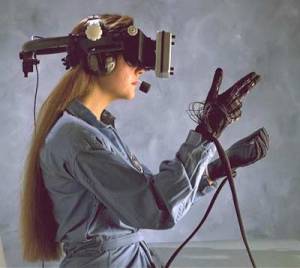
by Rich Mesch
I recently had the pleasure of speaking at the SALT conference in Arlington, VA. While there, I was fortunate enough to meet Dr. Keysha Gamor, a fellow-presenter who also has a passion for Virtual Immersive Environments and 3D Learning. Keysha was good enough to allow me to interview her for this article.
Given its location, it probably won't surprise you that the SALT conference attracts many participants from Government and Military, some of the earliest advocates of 3D Learning. Keysha works extensively with both areas, so I was anxious to learn about her experiences. But what most intrigued me is that Keysha's perspective was firmly rooted not in Virtual Worlds, but in Virtual Reality. What connections can we make, I wondered, between the effectiveness of Virtual Reality (VR) and the effectiveness of Virtual Worlds?
As part of her graduate work, Keysha worked with the University of Georgia and NASA to determine how fully immersive VR could be used to teach complex abstract concepts. The goal of the study was not to look at VR as a unique or special interaction, but from the perspective of everyday usage in a teaching environment. The study, called “The Science Space Program,” focused on teaching science concepts to middle school and high school students, and utilized some pretty serious VR equipment that was shuttled from school to school.
Activities in the study included exploring concepts like velocity (what happens to an object going at high rates of speed?), static electricity, and other types of physics issues. Except that rather than focusing on abstract concepts, students were actually able to get inside a particle; they could actually become the particle to understand what happens to it. Students participated in groups of 3; one student would wear a head-mounted display, another would direct his/her activities, and a third would observe. Each student got to play each role.
For the final exam, each student designed their own rollercoaster, using physics concepts they had learned. Keysha says she was amazed at how well they were able to do—the accuracy of the mathematics and physics used by the students in creating their rollercoasters was remarkable. It’s worth noting that these were “average” students, not gifted; students who were incapable of comprehending these concepts before succeeding with the VR exercise.
It’s a great story, and a great example of how contextualized learning drives comprehension and application. In fact, the first question I asked Keysha was around context; didn’t the success of the study indicate the value of contextualization, and not necessarily VR? Aren’t their other ways of contextualizing learning to have a similar outcome? Her response was, yes, it was definitely about context, but the VR technology provided a contextualized experience that couldn’t be provided any other way.
Most of us don’t have Virtual Reality equipment cluttering up our offices. So are their ways to have a similar impact using more readily-available Virtual Immersive Environment (VIE) technologies? Well, Keysha and I discussed that as well… and I’ll report out on our conversation in the next entry in this series!


